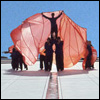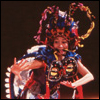Good News
Los Angeles Times Magazine January 12, 1986
Rituals for the 80's
The Unusual Performances of Choreographer Yen Lu Wong
By Bevis Hillier
Meeting Yen Lu Wong makes you feel that you are living life on too shallow a level. The Los Angeles dancer and choreographer seems to read profound symbolism into everything and to juggle space and time with Einstein-like dexterity. William Blake wrote of seeing the world in a grain of sand. Wong perceives the universe in a grain of rice. Rice is the theme of the latest...dance?...happening? What should one call it?... that she is planning to stage with Moebius, the performance ensemble she and her husband, Herbert Shore, founded in 1972.
For the production, artist Francoise Gilot (the mother of Picasso's children, Claude and Paloma, and now the wife of Jonas Salk, discoverer of the polio vaccine), has designed a pressed-paper mask - a white, gaping face of holy vacancy.
When I look at one of Wong's dance events, I am struck by the artistic tableau: melodramatic posing of figures flaming with colored robes, swathed in bandages or poised in combat with bamboo staffs. But when Wong talks about her latest work and what it means, we are soon in the realm of symbolism.
"The work is about transformation," she says. "Rice is eaten by more than three quarters of the population of the world, and it is the oldest grain cultivated. The technology and the wisdom that it took to harness the grain are, I think, a kind of psalm to man's potential."
Something else that interests Yen Lu Wong - and her we get into deeper water still - is the spiral. Or, rather, the helix. "The spiral and helix have basically one difference, " she explains. "The spiral presumes a point, but the helix is open. And I feel that for humankind to enter the 21st Century, we need to come to a different level of consciousness. If we are to go up in a holocaust, some of us want to go with at least some beauty and with a sense of joy, of celebration."
She's lost me, by now, I am conscious that I am talking to a person of high intelligence and great sincerity. But I'm a fellow who lives rather on the surface of things. I don't often think about how I intend to comport myself in a holocaust. And I'm not quite sure how that fits in with rice and helixes, either. I ask Wong: "How can you go up with joy and celebration when a hydrogen bomb drops on you?"
"We have to live day by day", she replies with Delphic concision.
"Do you mean that the very moment it drops, we should be living in a good way?"
"Uh-huh. And that, actually, is not contrary to Buddhist thought - that the way you die is the way you live, and that life and death are, after all, not diametrically opposed, because the opposite of death is not life, it is birth, and between is life."
What are her religious views? "I don't belong to any institutionalized religion, but I grew up with Buddhism as a major part of my role-consciousness." She was born in Kunming, Yunnan province, in south-west China, near Tibet, the daughter of a manager of the Bank of China.
Wong's father was kind to the poor; he encouraged her to give them half of the money placed under her pillow at the Chinese New Year. But as a capitalist, he had a rough time from 1946 to 1949, the time of the Chinese Revolution. In 1950 the family moved to Hong Kong, where Yen Lu Wong had her basic schooling. She came to the United States in 1958 to study medicine at Tufts University. In the summers. she studied at Columbia Medical School. And at Columbia, her career was changed when she met Martha Graham, who had founded the Center for Contemporary Dance there. Wong was impressed that Asians, blacks and whites were dancing together at the Graham Center.
For Wong, as a comparatively rich girl in China, a career in theater or dancing had been out. It was not socially acceptable to join the Peking Theater. And when she studied ballet in Hong Kong, most of the students were English, and the English dancing teacher told her: "We can't have one of the swans (in 'Swan Lake') a different color." After training with Graham and at the Laban Institute, New York, Wong became an independent choreographer and an American citizen; but 10 years after taking citizenship, she was still irked by references to her as "the China-born choreographer" or "the Chinese-American choreographer." When she traveled, it was always her passport that was requested on the bus at the Mexican border. She decided to confront the problem at her work.
The result was a spectacular production staged in 1977 at the Salk Institute, La Jolla, the last building designed by architect Louis Kahn. The work was entitled "Golden Mountain" the phrase that the Chinese immigrants of the late 19th Century used for San Francisco in particular and California in general. It was about the exploited Chinese. "They laid the railroads, dug the mines, irrigated the fields, sewed the garments and later seemed to disappear into the steam of the laundries, " Wong says. The performance moved Jonas Salk to tears, and after seeing it, Francoise Gilot said she wanted to design masks and costumes for a Wong production.
The work on which the two women are collaborating - the one with rice as the central symbol - is called "Shimei," a Japanese word that means "binding and unbinding." A trial run was staged in June at the John Anson Ford Theater, opposite the Hollywood Bowl. "It's an outdoor theater set in the hillside with rock staircases," Wong says. "Sometimes you see goats and deer coming down from the Hollywood Hills." Wong disguised the rocks and bushes. She was glad to be able to give the work a showing, but to her, the setting was not right. "I'm always looking for sites that have a special power, " she says.
In 1979, the Australian Council gave her the chance to stage a work called "Between Silence and Light" at the Sydney Opera House, with aborigines among the performers. In 1980, her "Seres Ceremonials" (with silk as the central theme) opened the Japan American Cultural and Community Center Gallery in Los Angeles. Recently she has been discussing with Arthur Erickson, the Canadian architect, the idea of putting on performances in buildings by him. Erickson is designing the downtown Dance Gallery that will open in two years.
Wong thinks that Los Angeles does not have enough gathering places. "I would say that the central thrust of all my work is to try to find rituals for contemporary society, new events and meeting places," she says. The trouble with Los Angeles, she finds, is that "it's not a centripetal city, it's a centrifugal city. It disperses rather than gathers. We have Griffith Park, but unlike Central Park in New York City, its not central.
So what is the point of gathering and having rituals? To let off steam? "I prefer to use the word celebrate," Wong says, "because inherent in celebration is the whole capacity to be Dionysian; yet at the same time it's not just a 'block party.' in finding a ritual for contemporary society, one of the key elements is to provide a chance for meditation - a moment to reflect, to be spiritual. There is a quest for that in Los Angeles. You have these Jacuzzis all over the place that induce a certain kind of meditative ambiance. People say, 'Relax!' But I think that it's not just relaxation that we're looking for. It is a harmonious interplay among the mind, the body and the spirit."
If Wong can't get the people to her performances, she will get her performances to the people - with videotapes. She received a Mobil Corp. grant of $10,000 to study the possibilities and problems of video. "For example, the human body remains vertical most of the time," she says. "It took millions of years of evolution to get that way. Yet the television screen is a horizontal rectangle. What television has done is to cut the body in half - so you always see people from the waist up. And you also know that the action can be full of movement and the camera could be dead, and what comes across is almost static. The grant enabled me to explore these problems." Now she is putting together a team of investors and a team of video makers to bring her works to the world.
"I could just go to a mountaintop and dance with the sun and stars,"she says, "but I am concerned with dance as a social activity. The kind of meditative dance I'm involved in helps to unite body, mind and spirit. I don't think you could say the same for aerobics with Jane Fonda.






